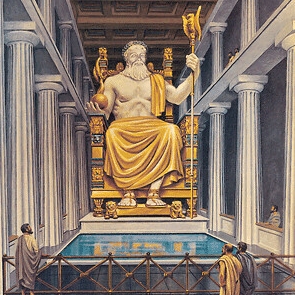Among the magnificent sculptures in Olympia, Greece, the Olympia Greece Zeus Statue is undoubtedly one of the most eye-catching artistic masterpieces. This sculpture is not only famous for its huge size and exquisite craftsmanship, but also highly respected for its important position in Greek mythology and culture.
The statue of Zeus was created by the ancient Greek sculptor Phidias around 435 BC and is located in the Temple of Zeus in Olympia. The statue is about 12 meters (40 feet) high and is a muscular Greek sculpture, showing the image of the god Zeus sitting on a magnificent throne. His body lines are strong and smooth, and his muscles are portrayed in a detailed and powerful way, reflecting the ultimate pursuit of human beauty and the expression of divinity in Greek sculpture.
The materials of the Zeus statue are mainly ivory and gold. This technology of combining precious materials was unprecedented at the time. Ivory was used to shape Zeus’ skin, while gold was used to decorate his clothes and throne. This design not only shows Phidias’s superb skills, but also reflects the degree of worship of its gods and the luxury of artistic expression in ancient Greece.
In addition, the statue of Zeus also has important historical significance. It is not only the central landscape of Olympia, but also a symbol of all ancient Greek religious and cultural activities. The statue of Zeus in Olympia is even regarded as one of the seven wonders of the ancient Greek world, symbolizing the pinnacle of ancient Greek culture.
Although this sculpture has been lost in the long river of history, we can still feel its original grandeur and beauty through ancient documents and replicas. Modern replicas try to reproduce part of the style of this sculpture, allowing modern people to glimpse the glory of ancient Greek art.
In short, the Olympia Greece Zeus Statue is not only a masterpiece of ancient Greek art, but also a precious treasure of human cultural heritage. The historical and artistic value of this sculpture makes it transcend a simple religious symbol and become an indispensable part of the study of ancient Greek history and culture.


